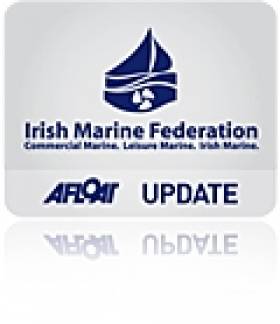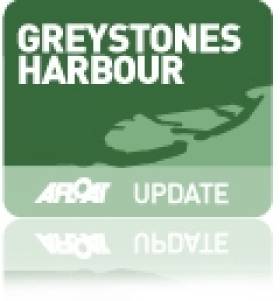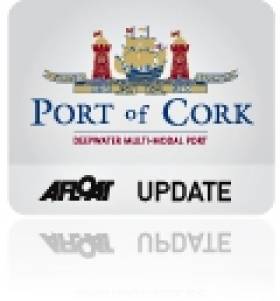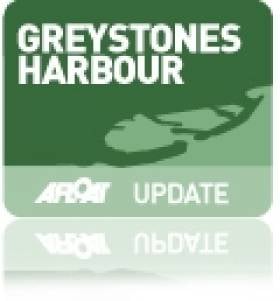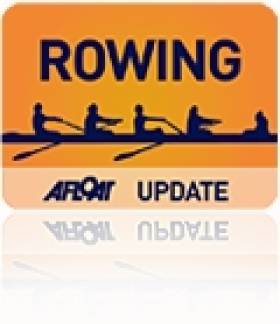Displaying items by tag: Marina
Celtic Mist to Berth in Kilrush Creek Marina, Co Clare
Shannon Development is sponsoring the IWDG by providing a berth for Celtic Mist at Kilrush Creek Marina as the Company sees it as an important asset for West Clare. Shannon Development's Regional Development Manager for Clare Finbarr Brougham said: "We are delighted that IWDG secured Celtic Mist for Kilrush Creek Marina as it will provide a significant focal point of interest in the Marina and should attract a number of visitors to the yacht with the consequent knock on effect to the town of Kilrush. We would like to take the opportunity of wishing the Irish Whale and Dolphin Group every success in relation to the future use of Celtic Mist."
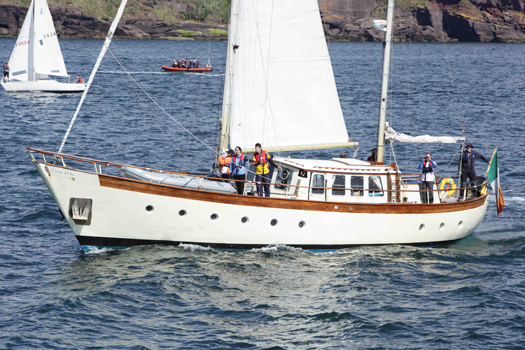
Celtic Mist is heading for Kilrush. Photo: Shay Fennelly
The yacht will be used for research and surveying for whales, dolphins and other marine wildlife in Ireland. It will also be used for training people to carry out marine surveys including the use of acoustic monitoring with towed hydrophones.
IWDG Co-ordinator Dr Simon Berrow said: "The marine wildlife around Ireland is superb, with whales, dolphins, seals, seabirds and basking sharks abundant at different locations and times of year. However we still know relatively little about what occurs where and why. Celtic Mist will provide a fantastic platform from which to survey Irish waters and help us learn more about this fantastic resource."
All are welcome to visit Celtic Mist when she arrives in Kilrush on Saturday 16 July. The expected time of arrival is between 1500h and 1600h but it is advisable to check www.iwdg.ie for confirmation.
As the cost of running a yacht like the Celtic Mist will be a major drain on scarce resources, the IWDG are looking for sponsors to help them fund its operation. Anyone interested can get further information by contacting IWDG at www.iwdg.ie
Trade, Tonnage and Turnover Up in Belfast Harbour
The principle driver in the ports performance came from the agri-food sector with a record 2m tonnes of grain and animal feed imports. The sector also recorded fertiliser imports alone leap by 32%, reflecting the major investment by the harbour in recent years in the dry-bulk cargo trade.
Roll-on roll-off (Ro-Ro) accounted for a 2% rise to 313,000 vehicles carried, partly due to the introduction of newer larger tonnage on the Belfast-Heysham route.
Belfast Harbour Chairman, Len O'Hagan, said: "Although trading conditions in the UK and Ireland remain weak, the increase in tonnages handled by Belfast Harbour suggests that business confidence is starting to return, albeit slowly.
"Belfast Harbour continues to operate in a highly competitive port sector, but I am pleased to note that the £160m which the Harbour invested in new facilities during the past decade has enabled it to emerge from the downturn with new customers and a presence in new sectors such as renewable energy.
Capital investment in the port worth almost £6m were undertaken during 2010, including the purchase of a new mobile crane, a 10,000 sq ft expansion in logistics space and preliminary works to support the proposed development of an offshore wind turbine terminal for DONG Energy (click HERE). The combined capital expenditure in these projects is in excess of £60m.
Within the ports real estate, projects at the Titanic Quarter progress at the Public Record Office, Belfast Metropolitan College and the core attraction of the 'Titanic Belfast' visitor centre.
Master planning for the 24-acre mixed-use City Quays site adjacent to the Harbour Office was secured. In addition planning permission was lodged for a 230,000 sq ft of space at Sydenham Business Park on the south-eastern fringes of the harbour.
Further upstream closer to the city-centre at the Abercorn Basin, initial work had been completed on a marina where there are more plans for the development of a 250-berth full-service leisure facility.
Next Monday the port's cruise business is to welcome a new cruiseship, the 66,000 tonnes Marina of Oceania Cruises. The 1,250-passenger /800 crew newbuild's arrival to Belfast comes in a year that marks the thirteenth anniversary since the first liner docked in the city. In 2011 over 30 such vessels are due to visit bringing some 50,000 passengers and crew.
- RORO
- Marina
- Port of Belfast
- Titanic
- Belfast Lough
- Belfast Harbour
- Titanic Quarter
- Len O'Hagan
- Belfast Harbour Commissioners
- Cruiseships
- Ports and Shipping News
- Dong Energy
- BelfastHeysham
- Belfast Lough News
- Drybulk
- Abercorn Basin
- Belfast Harbour Chairman Len O'Hagan
- Titanic Belfast
- Marina Oceania Cruises
- Offshore Wind Turbines
- Belfast Metropolitan College
- Sydenham Buinsess Park
- Belfast Harbour real estate
Oban Marina Gets Ready for Busy Season
It's not part of the necklace of marinas around the Irish coastline but at just 150 miles from Carlingford, Oban Marina in Scotland is one of the closest to it. The modern marina is based on the picturesque Isle of Kerrera and it is the gateway for many Irish boats heading for the Scottish West Coast.
This summer, Oban marina will welcome several new regattas with competitors from afar afield as Denmark.
Following expansion in 2010, the marina can now accommodate up to 145 visiting yachts on fully serviced pontoons and swinging moorings. Its marina and boatyard services, plus proximity to some of the most spectacular cruising and racing grounds in the world, has increased its attraction to regatta organisers world wide.
This year Marina Manager, Sue Deacon and her team, will welcome several new high profile events with yachtsmen from overseas as well as those closer to home:
"We have already played host to competitors taking part in the Sebago Round Britain and Ireland Challenge and Scottish Peaks Race," says Sue Deacon. "Next month (July), we are looking forward to welcoming a very special visitor - the ex-Royal yacht, Bloodhound, who will use Oban Marina as her base for several weeks chartering this summer. World Cruising Club's Malts Cruise will also make Oban Marina their base before the start of this popular event and around 40 yachts will sail to Oban Marina from Denmark as part of the Danish Ocean Cruising Association's rally."
Organisers are happy to use the marina as a convenient stop-off point for their event and the facilities ashore include a restaurant, bar and use of a boatshed for larger functions. Charlie Walker, Managing Director of the Sebago Round Britain and Ireland Challenge explains: "We were delighted to bring the yachts into Oban and it was the perfect choice for the West Coast of Scotland stopover as Oban Marina has great facilities and all tides access."
Summer home port for Ex-Royal Yacht
With Royal wedding fever at its height, the marina is looking forward to its own royal visitor - Bloodhound, the fully restored classic 1930s yacht which once belonged to Her Majesty The Queen and His Royal Highness The Duke of Edinburgh. Bloodhound now belongs to the charitable trust that also owns and manages the five-star visitor attraction, The Royal Yacht Britannia in Edinburgh. She is normally on view to visitors throughout the year as the centrepiece of a new Royal Sailing Exhibition.
The legendary racing yacht will be available for charter out of Oban Marina this summer from 11 July until 24 August and up to 8 guests will be able to enjoy sailing through the stunning scenery of Scotland's West Coast, as well as the hospitality of the skipper and crew, who are all former HMY Britannia 'Royal Yachtsmen'.
Bob Downie, Chief Executive of The Royal Yacht Britannia is pleased to be bringing Bloodhound back to the West Coast and to Oban Marina: "We are delighted to be taking Bloodhound back to the waters on which she once sailed with the Royal Family. She is such an important part of British sailing history, and this really is a once in a lifetime opportunity to step back in time."
Malts Cruise
Up to 40 yachts taking part in World Cruising Club's Malts Cruise will be welcomed at Oban Marina for two days on 8/9th July and to mark the start of the event, a buffet supper and ceilidh will be held in the marina's 'Boatshed'. It is sure to be a memorable party, setting the tone for the remainder of the cruise. The start on Sunday 10th July will include a spectacular Parade of Sail as the fleet head off to their first stop in Tobermory. Yachts then select their own route to the next rendezvous in Port Ellen, allowing exploration of the islands and secluded anchorages of the West Coast. The event supported by Diageo's Classic Malts Selection, is not just about sailing though, as the Malts Cruise is a wonderful opportunity to experience traditional Scottish hospitality, local specialities like scallops and whisky, and to have a great time with fellow cruisers.
http://www.worldcruising.com/maltscruise/
Danish Rendezvous
The Danish Ocean Cruising Associations's Pennant will be flying high to welcome around 120 sailors in over 40 boats from Denmark. Weather permitting, the fleet should arrive at Oban Marina on 11th/12th July before heading off to enjoy the rest of their malts cruise. After staying for a few days to enjoy local hospitality and the marina facilities, Coordinator, Karsten Pennov said: "Everyone is very enthusiastic about the event and we are very much looking forward to staying at Oban Marina."
West Highland Yachting Week 29th July to 5th August.
Once again, Oban Marina will be hosting competitors in West Highland Yachting Week with a ceilidh, seafood grill and BBQ on Sunday 31st July overlooking Oban Bay. Boats will be at the marina from 31st July to 3rd August.
"The impressive turnout at the conference this year has shown that Asia is the new frontier," commented YP Loke, Chairman of Singapore Boating Industry Association. "SBIA are really delighted to have hosted such a successful conference. From the content presented and discussions that took place, it was clear that there is dramatic development and huge growth happening in the region."
The conference programme covered content in marina operations and management as well as planning and development. Panel sessions and presentations saw discussions on the state of the global marina industry with a big focus on emerging markets. Discussions included topics on drystack storage, best practice operational issues, effective online marina promotion and marina industry education and training.
Networking breaks allowed for delegates to visit the sponsor booth arena, where over 25 marina suppliers showcased their products. Silver Sponsor, Camper & Nicholsons Marinas announced their newly formed partnership with BR Marinas. The partnership marks the cooperation towards the growth of luxury marinas in Brazil. The agreement reflects the growing importance of international networks in the marina business combining various experiences, knowledge and skill base.
The near 700-passenger capacity ship operated by UK based Voyages of Discovery is scheduled to call at several Scotish ports before returning to Portsmouth via the North Sea.
Discovery has eight decks with facilities to include two swimming pools, one with a retractable roof, jacuzzis, lounges, bars, a library and gymnasium, lecture theatre, cinema, restaurants, an internet cafe, shop, beauty salon and a medical centre.
She was built in 1971 as the Island Venture, then renamed Island Princess after purchased by Princess Cruises, alongside her sister Pacific Princess which appeared in the popular US TV series sitcom the 'Love Boat' broadcast by ABC between 1977-1986.
In total there will be four cruise-calls during the season to Douglas but the next visit will be not until July when P&O Cruises Adonia calls on the 17th. The ten-year old 710 passenger vessel is due to be named by Dame Shirley Bassey at a ceremony held in Southampton later this month.
Also calling to Douglas will be Oceania Cruises brand new 60,000 tonnes / 1,250 passenger Marina on the 24th July and the final call is to be made by Noble Caledonia's Japanese built Clipper Odyssey in mid-August.
- Killybegs
- Cork
- Discovery
- Marina
- Ringaskiddy
- Cruise Liners
- Princess Cruises
- southampton
- Isle of Man
- P&O Cruises
- Ports and Shipping News
- Manx
- Voyages of Discovery
- Douglas
- Douglas Bay
- Adonia
- Dame Shirley Bassey
- The 'Love Boat'
- ABC
- Pacific Princess
- Island Princess
- Oceania Cruises
- Cruise Liner news
- Clipper Oydessey
- Noble Caledonia
Council Bond Ensures Greystones Harbour will Open - Councillor
Wicklow Councillor Derek Mitchell has moved to reassure frustrated boaters and townspeople alike that the partially completed €300 million Greystones Harbour and Marina will be completed. In a letter to the Irish Times this morning the councillor acknowledges that the delays are 'frustrating' but advises the council holds a €5 million bond to ensure the project will be completed.
A recent survey of prospective boat owners found 80% of berths required in the proposed 200 berth marina would be under eight mertres. Mitchell admitted earlier this year more interest from boat owners was required to get the marina underway.
The council bond is not exercisable until 2014.
A slipway at the community harbour is operational but the public square and five free clubhouses for different boating activities from angling to sailing are still to be provided. Last November builders Sispar held an open day to show off the impressive marine works.
A spokesperson for development consortium Sispar previously advised the decision on funding the next phase rests with that National Assets Management Agency (Nama).
80% of Berths Required in Greystones are Under 8 Metres
A newsletter giving details of the most popular size berth requirements at the proposed Greystones Harbour Marina has been sent to boat owners on a waiting list for the Wicklow marina.
The analysis finds 80% of the berths required are under 10 metres (32 foot). Only 2 berths were required for boats over 13m (42 feet).
In nearby Dun Laoghaire, at the country's biggest marina, the 820 berths there range in size from 6m (19 feet) to 30m (98 feet). The average berth requirement on Dublin Bay is 9-10m (29-32 feet).
The March newsletter says examination of the waiting list revealed duplication of an original waiting list which prompted a fresh exercise to establish the current market demand in 2011. The new survey of 300 people was carried out by a marina consultant, working for developer Sispar. It delivered 79 responses. An extract from the analysis is below.
The tabulation from the newsletter reflects the breakdown of the responses in terms of current berth size numbers and the extrapolation into the requirement for totals when fully developed based on to-days statistics.
| Berth Size | Numbers to 6/1/11 | % of Current Market | Full Dev Berth Nos. |
|
| <6m | 9 | 12.4 | 29 | |
| 6-7m | 12 | 15.2 | 35 | |
| 7-8m | 14 | 17.7 | 41 | |
| 8-9m | 5 | 6.3 | 15 | |
| 9-10m | 17 | 21.5 | 50 | |
| 10-11m | 8 | 10.1 | 24 | |
| 11-12m | 6 | 7.6 | 18 | |
| 12m-13m | 6 | 7.6 | 18 | |
| >13m | 2 | 2.6 | 5 | |
| Total | 79 | 101 | 235 |
Clarion Hotel Promotion for Port of Cork Marina Visitors
Captain Pat Farnan, Port of Cork Harbour Master said: "The Port of Cork opened this new marina in 2010 and experienced a busy summer of visitors. We are aiming to attract more local and visiting boats to the marina this summer and we feel the joint promotion with the Clarion Hotel will be very effective."
He continued: "We hope to do further promotions around the marina throughout the summer."
The Port of Cork City Marina is ideally located in the heart of Cork City offering 150 metres of berthage with 24hr security, water, and electricity and refuse facilities. The Clarion Hotel is within 100m of the Port of Cork City Marina, making it ideally located for marina users who want to use the shower facilities.
The Port of Cork City Marina is a long term investment for the City of Cork which the Port of Cork implemented as part of their Leisure and Recreation Strategy for Cork Harbour. The primary focus of the strategy is on water based Leisure and Recreation activities in and around Cork Harbour in which the Port of Cork aims to play a leading role in providing and supporting improvements of amenities in these areas.
Cork Harbour offers significant potential for further development of the marine recreation sector as an important source of enjoyment and economic gain for the local residents and visitors. The Port of Cork, primarily providing commercial services to its customers, is conscious of its responsibility to all other stakeholders in Cork Harbour.
In Cork, the world's second largest natural harbour, it is critically important for both commercial and leisure to work together in harmony. The Port of Cork is committed to achieving this while also respecting the principles of environmental sustainability and corporate social responsibility.
Operating guidelines and charges for the Port of Cork City Marina are HERE
More Interest Required to Open Greystones Marina
There was good news in Wicklow for watersports fans with the opening of the new public slip at Greystones harbour last August but there was disappointing news from Cllr Derek Mitchell yesterday who conceded that"currently not enough boat owners have expressed interest in paying for berths in the planned marina. This could mean completion of the 220 berth marina could be delayed beyond 2011.
Last October concern was raised over the Euro 300 Million redevelopment of the harbour after the builders confirmed the project is to come under the control of Nama.
Currently the breakwater is complete but there is no marina furniture installed.
In an update on his website yesterday Cllr Mitchell believes that more boat owners are interested but they need to be contacted again.
It is expected through that over 80% of berths required are for boats under six metres, such as small local fishing craft.
The new public slipway however is open and it is possible to launch three boats at one time even at low water (when most slips run out of water), which is a great improvement. At the moment it is understood only limited access is available to the slip as building works are ongoing. When finished there will be a second wide slip and the town council maintains the new facilities will be the best public boat launching facilities in the country.
Aerial photo of the site HERE
More Greystones news HERE
Cork Crews Rise to the Top at Cork Head
Cork crews saw off rivals from far and near at the Cork rowing Head of the River at the Marina on Saturday. UCC’s men’s senior eight were the fastest men’s crew – by 1.3 seconds from De Maas of Rotterdam, a masters eight. The fastest women’s crew was Cork Boat Club’s junior 18 eight, adjudged just .8 of a second quicker than UCD’s women’s senior eight. The fastest men’s single sculler was John Keohane of Lee Valley and Karen Corcoran-O’Hare of Shandon was the fastest women’s single sculler.
Cork Head of the River, The Marina, Cork, Saturday
Overall: 1 UCC men’s senior eight 12 minutes 6.7 seconds, 2 De Maas, Rotterdam men’s masters eight 12:08.0, 3 UCC men’s novice eight 12:25.9, 4 UCD men’s novice eight 12:42.4, 5 Presentation College men’s junior eight 12:44.3, 6 Muckross intermediate eight 12:49.9.
Men, Eight – Senior: UCC 12:06.7. Intermediate: Muckross 12:49.9. Novice: UCC 12:25.9. Junior: Presentation 12:44.3. Junior 16: Cork 13:21.2. Masters: De Maas 12:08.0.
Fours – Senior: Cork/Garda 12:53.6. Intermediate: UCC 13:40.6. Novice: Cappoquin 13:43.9. Junior 18, coxed: Presentation 13:04.0
Pair – Junior 18: Presentation 14:58.7. Masters: De Maas 13:09.9. Coastal – Novice: Ahakista 17:28.7.
Sculling, Quadruple – Senior: Shannon 13:50.8. Novice: Shannon 15:07.4. Junior 18: Cork 13:05.3. Junior 16: Cork 13:15.2.
Double – Intermediate: Cork IT 13:41.6. Junior 18: Clonmel 13:53.9. Junior 16: St Michael’s 15:04.4. Coastal – Novice: Kilmacsimon 16:17.2.
Single – Senior: Lee Valley (J Keohane) 14:16.4. Intermediate: Lee (O’Connell) 14:53.4. Novice: Lee (O’Connell) 14:37.9. Junior 18: Workmen’s (Burns) 14:33.0. Junior 16: Shandon (Casey) 15:08.9. Masters: Skibbereen (Barry) 15:40.07. Coastal – Novice: Kilmacsimon 17:33.6
Women – Overall: 1 Cork junior eight 13:40.0, 2 UCD senior eight 13:40.8, 3 St Michael’s junior eight 13:54.1.
Eight – Senior: UCD 13:40.8. Novice: UCC 14:25.4. Junior 18: 1 Cork 13:40.0. Junior 16: Clonmel 16:21.0.
Four – Senior: Muckross 14:15.9. Intermediate: UCC 17:00.9. Novice: UCC 16:29.8. Masters: Skibbereen 22:34.9.
Pair – Junior 18: St Michael’s 15:00.2.
Sculling, Quadruple - Novice: Shannon 15:51.4. Junior 16: St Michael’s 15:16.5.
Double – Intermediate: UCC 16:15.1. Junior 18: Cork 14:43.9. Junior 16: Lee 15:42.3. Masters: Cork 15:38.3.
Single – Senior: Intermediate: Shandon (K Corcoran-O’Hare) 15:39.7. Junior 18: Lee (Kearney) 16:52.1. Junior 16: Lee (Hamel) 16:13.6. Masters: Cork (Crowley) 17:49.2.
Coastal: 1 Kilmacsimon men’s novice double scull 16:17.2, 2 Ahakista men’s novice quadruple coxed scull 17:28.7.
Click this link for Irish Rowing detailsClick this link for the Latest Rowing News































